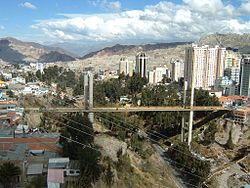Historical and architectural interest bridges
| Name | Distinction | Length | Type | Carries Crosses | Opened | Location | Department | Ref. | ||
|---|---|---|---|---|---|---|---|---|---|---|
 | 1 | Méndez Bridge | 208 m (682 ft) | Suspension Wooden deck, masonry towers | 19th century | Sucre – Betanzos 19°21′19.3″S65°10′38.7″W / 19.355361°S 65.177417°W | Chuquisaca Department Potosí Department | [Note 1] [1] [2] | ||
| 2 | Horacio Guzmán International Bridge | Argentina–Bolivia border | 31 m (102 ft) | 1960 | Villazón – La Quiaca 22°05′47.5″S65°35′46.4″W / 22.096528°S 65.596222°W | Potosí Department | ||||
 | 3 | Wilson Pinheiro Binational Bridge | Bolivia–Brazil border | Cable-stayed Composite steel/concrete deck, 1 concrete pylon 77+42 | Road bridge Acre River | 2004 | Cobija – Brasiléia 11°00′58.0″S68°45′05.5″W / 11.016111°S 68.751528°W | Pando Department | [S 1] |


